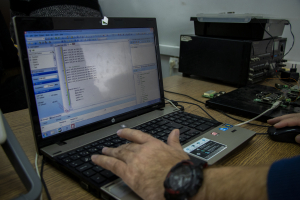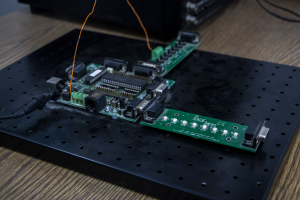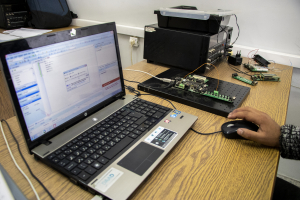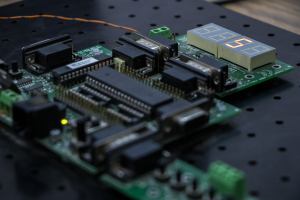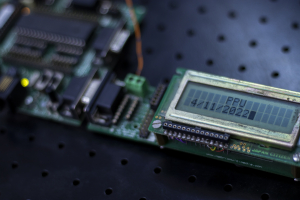The microcontroller lab was established in 1994 within the Department of Electrical Engineering. This lab primarily caters to students from various disciplines within the department, with a specific focus on the microcontroller course. The lab's primary goal is to provide students with hands-on experience in configuring and programming microcontrollers using the C++ programming language. This practical approach is designed to enable students to design and implement algorithms for embedded systems using microcontroller. These embedded systems are responsible for collecting data from various sensors, processing this data based on specific algorithms and generating output signals to control different actuators.
The practical approach will take place in the lab through the execution of several experiments covering the key topics that were previously addressed in the course. These experiments will involve the use of different microcontrollers, including ATMEL and PIC, utilizing educational kits and breadboards. Additionally, a software tool will be used to simulate the microcontrollers and embedded systems.
The lab covers a range of competencies and skills essential for students. Firstly, it equips students with the knowledge of how to utilize microcontroller peripherals effectively. This knowledge extends to implementing various algorithms, allowing them to harness the full potential of these components. Moreover, students learn how to configure microcontrollers based on datasheets, ensuring optimal performance for specific applications. Programming proficiency in C++ is a core focus, enabling students to program microcontrollers in optimized way for embedded systems.
In addition, students gain expertise in data acquisition, enabling them to work with both digital data and analog sensors. The lab also teaches students how to interface microcontrollers with a variety of actuators and sensors, a skill crucial for integrating these components into projects and systems. Furthermore, students also assemble the microcontroller practically on a breadboard with different sensors and actuators.
In this practical learning environment, students have the opportunity to practice these skills on various microcontrollers from renowned companies like ATMEL, PIC, and Freescale. Real-time algorithm implementation is another significant aspect of the lab, ensuring that students can create embedded systems that respond swiftly and efficiently to changing inputs and conditions. These competencies and skills collectively empower students with a well-rounded understanding of microcontrollers and their applications in various contexts.
The lab's intended audience consists of students from the electrical engineering and mechanical engineering disciplines, which include:
- Electrical Engineering students: Electronics, biomedical engineering, renewable energy, electrical automation, communication engineering, and computer engineering and technology students
- Mechanical Engineering students: (Mechatronics and vehicle engineering).
- Science Students (Biotechnology and physics).
- Microcontroller
- Embedded systems
- Control systems
- Graduation Projects
- Microcontrollers and microprocessors (PIC, ATMEL, Freescale, ESP32 and Raspberry Pi).
- Microcontroller programmer
- Power Supplies
- Signal Generator
- Oscilloscope
- Logic Analyzer
- Digital Mustimeters
- Breadboards
- Electronics components (Op-Amp, Transistors, Diods and Digital logic IC’s)
- Sensors and Actuators
- Laptop’s
Occupational health and safety instructions are diligently upheld in the lab to prioritize the safety and well-being of all occupants. These guidelines encompass the use of personal protective equipment and safe equipment handling practices. Chemical and electrical safety measures are in place, and individuals are expected to be well-versed in emergency procedures and first-aid protocols. Hygiene and lab cleanliness are essential, with strict prohibitions on food and drink in the lab area. Proper ventilation and equipment shutdown procedures are to be followed. Moreover, students are encouraged to actively engage with lab supervision and promptly report any safety concerns or incidents. These instructions collectively create a secure and responsible learning environment.
Eng. Mohammed O. Al-Qaisi

